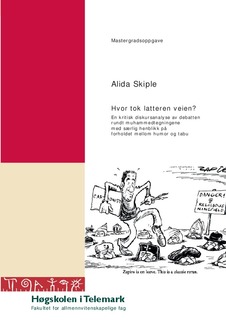| dc.description.abstract | This master thesis is focused on the relationship between the phenomena laughter and taboo. The relationship will be exemplified with the Danish Muhammad drawings published in Jyllands-Posten, September 2005. The thesis outlines the initial background for publishing the drawings and some of the general reactions to them. The different reactions represent different discourses, which I will try to identify trough a textual oriented discourse analysis. I have selected a number of texts from different newspapers, which all together represent the debate that followed the drawings. The texts are both from Danish and Norwegian sources, as the debate was stirred up in Norway when a small Christian newsmagazine decided to publish the Danish drawings in January 2006. Since my main focus is on laughter, I am trying to locate how, if even at all, laughter is emphasised in the different discourses. To understand better what I am looking for I have written a chapter about the theory of laughter based on Mikhail Bakhtin and Henri Bergson's different theories. Whereas Bakhtin focuses on the positive effects of laughter, Bergson is concerned about the negative, and these two opposites will be consistently throughout the research. The theory chapter also includes Mary Douglas theory about taboo, and the purpose of making and keeping something taboo. When it comes to the drawings of Muhammad, which some people regard as a breach of a taboo, they seem most of all to shed light on the different views people have on the freedom of speech, which was also the motivation for the publication. The different ways of understanding the word freedom can be connected to different discourses, which it is my purpose is to identify. In opposition to the freedom of speech discourse stands the religious discourse, whose representatives want to prevent expressions that can be read as negative towards religion. I have also found other discourses, which have different perspectives on the publishing of drawings. All discourses have in common that they try to give meaning to words like freedom of speech, respect, tolerance, religion, blasphemy, censorship and so forth. The overall purpose of this thesis is to find out which discourses are evident in the debate over the Muhammad drawings. And to find out to what extent the relationship between humor, religion and religious taboos have been discussed in the debate that followed their publication. | |
